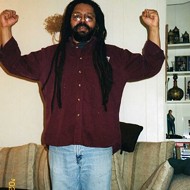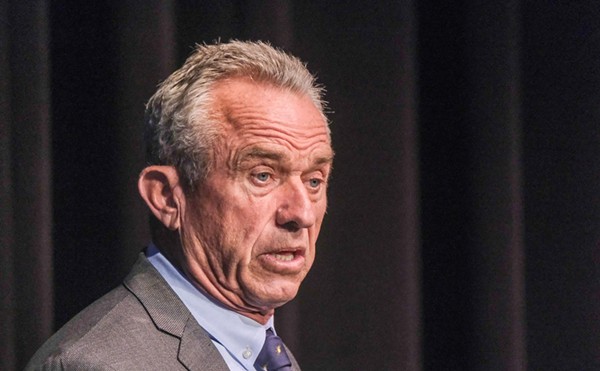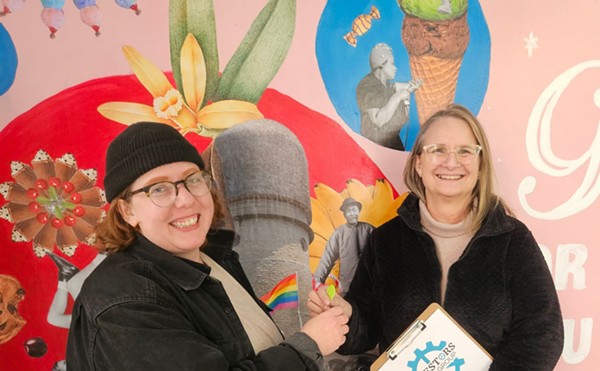"I had a run-in with Vicodin; that turned into a habit that I had to kick," said Laurent. "Opiate withdrawal — I never want to deal with that again."
Laurent isn't this Detroiter's real name. He didn't want to use it because he uses marijuana both medically and recreationally, and because he's young and hopes to become a social worker — maybe a substance abuse counselor — and doesn't want this column to pop up in some employer's search.
But Laurent has been through plenty of tough issues in life already. And he's been through plenty of pharmaceutical drugs. He started having crippling migraine headaches in 10th grade.
"They prescribed a lot of stuff to try to deal with them and nothing worked except Maxalt, but that would knock me out for hours," he says.
Laurent also suffers from a form of scoliosis known as Scheuermann's disease, an uncommon and painful condition that affects his spine. Having to deal with all that pain, it's no surprise that Laurent also struggled with depression, anxiety, and ADHD — and with the attendant drugs he was prescribed to deal with those ailments.
The 23-year-old is proud that he's been able to stop taking those drugs.
"I'm one of the few people who doesn't take pain medication," he says. "I could take a Vicodin and my back would feel better. But I also would have a panic attack, because I know where it leads."
Laurent uses medical cannabis to help manage his pain, for muscle relaxation, and to de-stress.
Chronic pain is the No. 1 reason medical marijuana patients give for their certification. A lot of the prohibitionist crowd sneers at this fact. They claim that many patients lie about their pain in order to gain access to the drug. But consider this: Pain is the No. 1 reason anybody seeks medical help; why shouldn't that be reflected among medical marijuana patients?
The problem of opioid painkiller abuse and addiction has become a worldwide problem, and a feeder for use of illegal drugs such as heroin and morphine.
It seems that since the major medical response (painkillers) to the major reason for going to the doctor (pain) is having such problematic outcomes, it would be good to explore an avenue (marijuana) that helps avoid those problems.
And marijuana does help with opioid painkiller abuse. An article in the June Journal of Pain, the official journal of the American Pain Society, reports on a cannabis and pain study that was done in Ann Arbor. Results found that: Cannabis use was associated with 64 percent lower opioid use in patients with chronic pain; cannabis use was associated with better quality of life in patients with chronic pain; and cannabis use was associated with fewer medication side effects and medications used.
And let us not forget: You can't overdose on marijuana because there are few cannabinoid receptors in the part of the brain that controls breathing and heartbeat.
The study is notable also because the Om of Medicine, a medical marijuana facility in Ann Arbor, participated with University of Michigan researchers from the School of Public Health and the Medical School. This has to be one of few studies in which a place that could be called a dispensary has participated. The Om staff is knowledgeable, and they have real discussions about your medical needs, unlike many other facilities.
There are many different kinds of pain and different approaches to handling them. Most medical marijuana is used for chronic pain from inflammation or injury, and for muscle spasms. Neuropathic (nerve) pain also seems to respond well to cannabis.
Treating pain with cannabis seems to be a highly individualized approach that balances the type and strength of the cannabis, the method of application, and the patients' familiarity, expectations, and apprehensions. Patients need to experiment, note how they feel, and discuss it with their caregiver. Smoking or vaping might be appropriate for some, topical applications with oils or creams might be more appropriate for others.
Laurent has found that edibles can be useful for back pain that he says is sometimes crippling.
"With edibles, the body high is a lot more intense," he says. "I'll use them when I don't have to go to work. They're very relaxing. It helps my back, but it also relaxes me. Outside of strains high in CBD, edibles help my back most. It's almost a complete body high."
Unlike with opioids, which actually kill pain, marijuana is a different experience. However, marijuana does seem to make pain more tolerable. I've heard a lot of folks say things which imply that the pain is still there, but you really don't care.
Jim, a local patient and Laurent's caregiver, suffers from back pain that has grown worse over the years. "Marijuana kind of puts it in the back of your mind rather than right there in the forefront," he says. "I know my back still hurts, but it just doesn't bother me right now ... It's the best pain relief I've ever found, nothing else is even close."
Jim is concerned that using THC makes it hard to concentrate while working. So he and his wife Michelle, a caregiver, have been experimenting with high CBD strains. They're expecting to get the Charlotte's Web strain that has become famous for helping child epilepsy patients reduce seizures.
There's a lot of excitement about CBD, as it's considered the component of marijuana that's therapeutically active but doesn't get you high. It is effective. However, many patients who use CBD find that is more effective when supplemented with a little THC. Emerging marijuana science is beginning to see an entourage effect of whole marijuana that is more effective than any one part.
There is one kind of pain that marijuana seems to be very effective at killing. Diabetic neuropathic pain, the tingling feeling that sufferers get in their extremities, is easily treated with cannabis. Those who suffer from it report that just a couple of puffs of marijuana make it go away. They also report that marijuana-infused oils and creams are very effective.
Menstrual cramps are also widely reported to be alleviated with cannabis.
I'm pursuing the ways that patients use cannabis to treat pain, and I hope readers will drop me a line through [email protected] to let me know how they are treating pain with marijuana — the success and the failures. I'm particularly interested in folks who are having success with Crohn's disease.
For Laurent, almost all of his medical issues are better with marijuana. The migraines that used to hit three to five times a week are down to once every few months. His back pain is relieved and bouts with depression and anxiety. Laurent doesn't consider it a cure-all for his problems, but more of a piece of the puzzle as he learns to manage the stresses of life. And the ADHD?
"Well, I can live with that," he says. "Just like every other drug, the goal for me is to get to a point where I don't need anything."
Good luck on that one. In the meantime, chronic pain is no joke, and it's great that he's found a way to handle it without having to be addicted to opioids.
A lot of folks jokingly refer to their experience when high or drunk as "feeling no pain." For those with chronic pain, it's no joke — and marijuana can help.
Recreational-medical vortex
Laurent discussed a thin line between his medical and recreational use of cannabis. These two categories seem to come together a lot. The "high" of marijuana is seen as an undesirable side effect by some, and a welcome part of therapy to others. Numerous medical marijuana patients first noticed that their medical symptoms "got better" when they were getting high in social situations.
Some medical marijuana supporters will claim that any marijuana use is medical. That idea argues that relaxing and distressing are therapeutic activities. Does having a couple of drinks after work to de-stress count as therapeutic? I don't know, but I'm willing to hear that argument. But if it is, then de-stressing with marijuana should be considered therapeutic.
"Recreationally I like smoking weed better than I like drinking; to each their own vice," Laurent says.
Let's not call it a vice. Rather, to each their own way of working through the stresses of life.







